Take a Brief Look at the History of İzmir with the Golden Box!
How about taking a brief look at the history of İzmir before starting our tour? The Metropolitan Municipality has prepared an excellent presentation for you in the Golden Box that it has placed in the city center to preserve the history and carry it to future generations. If you want this history to be reflected in your lenses with a state-of-the-art presentation, our first stop will impress you greatly!
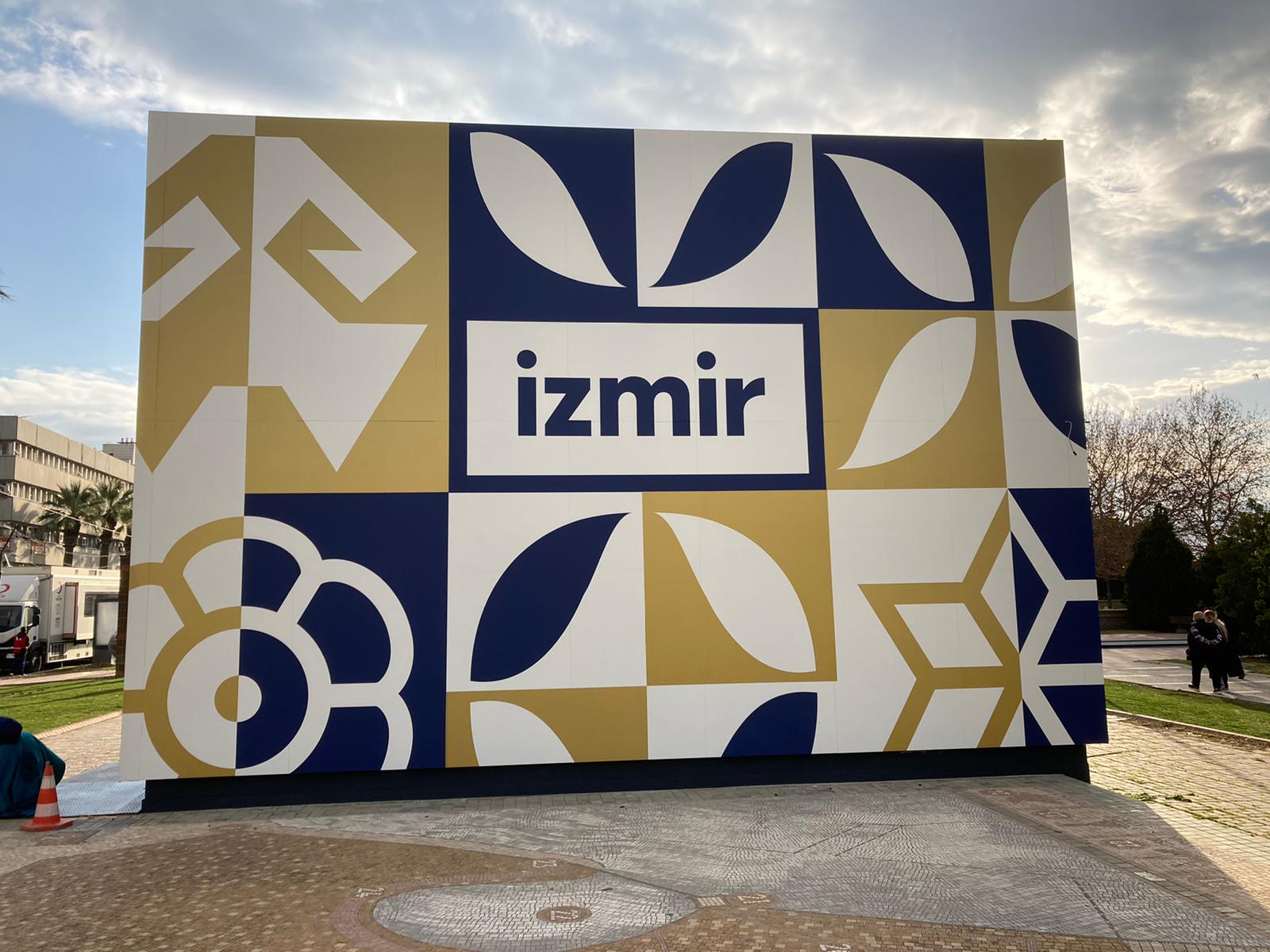
One of Turkey's most monumental examples of the orientalist style, the Clock Tower, was designed by the architect Raymond Charles Péré. The Clock Tower was built in 1901 to commemorate the 25th anniversary of Abdulhamid II's ascent to the throne. The cherry and green marbles used in the tower were brought from Marseille. The sultan's tughra (signature), which adorned the windows of the building in the form of reliefs during the Ottoman Period, was replaced with the crescent-star reliefs in the Republican Period. The canopy-covered fountains on all four sides of the Clock Tower, all cloaked with a dome, also rendered it an important water structure. The clock on the upper part of the tower is said to be a gift from the German Emperor Wilhelm II, and the section holding the clocks is accessed via a staircase leading up from the room on the ground floor. The tower's clock is wound every six days. The Clock Tower was restored by the İzmir Metropolitan Municipality on 15 July 2016.

Beyler ( The Gentlemen's) Street
The three streets in Kemeraltı, where the city's most prominent families would dwell, were named Beyler and divided into three sections; the first, the second, and the third. Although the streets of Beyler are no longer as lively as they used to be, they remain important in the city's memory. In the 20th century, Turkish-owned newspapers, publishing houses, and printing houses were located along Beyler Street. The National Library was first opened in Ahmet Ağa Mansion in the Second Beyler. Today, the mansion serves as the Department of Historical, Environmental, and Cultural Heritage following the restoration works of the İzmir Metropolitan Municipality. In the Second Beyler, the historical texture was re-discovered through the works carried out by the Metropolitan Municipality, reminding the city dwellers of the beauty of Beyler once again. While in Beyler, you can also stop by the famous white bean diner and cold cuts vendor, one of the city's renowned street delicacies. It would be good to remind you here that cold cuts used to be called 'tandirbas, a name originating from the local nomadic culture, and is known to hold a 500-year history in our culinary culture.

Yusuf Cavuşzade Ahmet Ağa commissioned Kemeraltı Mosque in the 17th century. Until recently, the information provided by Evliya Çelebi, also known as the "Ahmet Ağa Mosque," about the mosque was mistakenly thought to be related to the Kestanepazarı Mosque. Evliya Çelebi's writings also mentioned that the erection of the minaret required a lot of effort because a part of the land where the mosque was located was recovered from the sea. Beside the courtyard entrance of the mosque decorated with hand drawings, there also lays a fountain with remarkable Baroque adornments. Next to it is a marble drinking fountain known as both Kemeraltı and Sinanzade. Two important delicacies of the historical bazaar are found right next to the mosque: The first of these is the börek (patty), traditional food that was borrowed from the nomadic culture and included in the Ottoman cuisine, while the other is the delicious 'ezme' (paste) dessert with walnut, pistachio and almond varieties.
.png)
Ali Pasha Square, also called Ships Pier in the early 19th century, is one of the last areas created by land reclamation at the inner harbor. The square and the surrounding inns served as a kind of stock exchange until the establishment of the İzmir Commodity Exchange in 1891. Since the mid-19th century, the square has become the focal center of the bazaar. The symbol of Ali Pasha Square is the Hacı Salih Pasha Fountain. The fountain, built-in 1828 by the Grand Vizier Salih Pasha, took part in many engravings with the caravans that stopped to rest around it. The square, which for decades in the past was home to caravans, is now home to many local restaurants surrounding the fountain. Records of doner kebab, one of the most preferred delights in the square, date way back to Evliya Çelebi's Travel Book. It is also known that döner kebab, originally cooked horizontally, is referred to as 'İzmir Kebab' in cookbooks.

Balıkçılar Square
Designed with the contemporary architecture around a concept compatible with the historical texture of the historical Kemeraltı Bazaar, Balıkçılar Square was built by İzmir Metropolitan Municipality with plans to create a new attraction center in the bazaar. Undoubtedly, the most striking element is the statue of a woman fishing, and as the name suggests, the square is home to seafood restaurants and mussel sellers. We should also mention that in the excavations in Yeşilova Höyük (Mound), which extend the history of İzmir 8.500 years into past, mussel was discovered to be a staple food source for the people of İzmir. Today, it has become one of the irreplaceable street delicacies in the form of stuffed mussels, also known as Armenian appetizers among the Ottoman people.
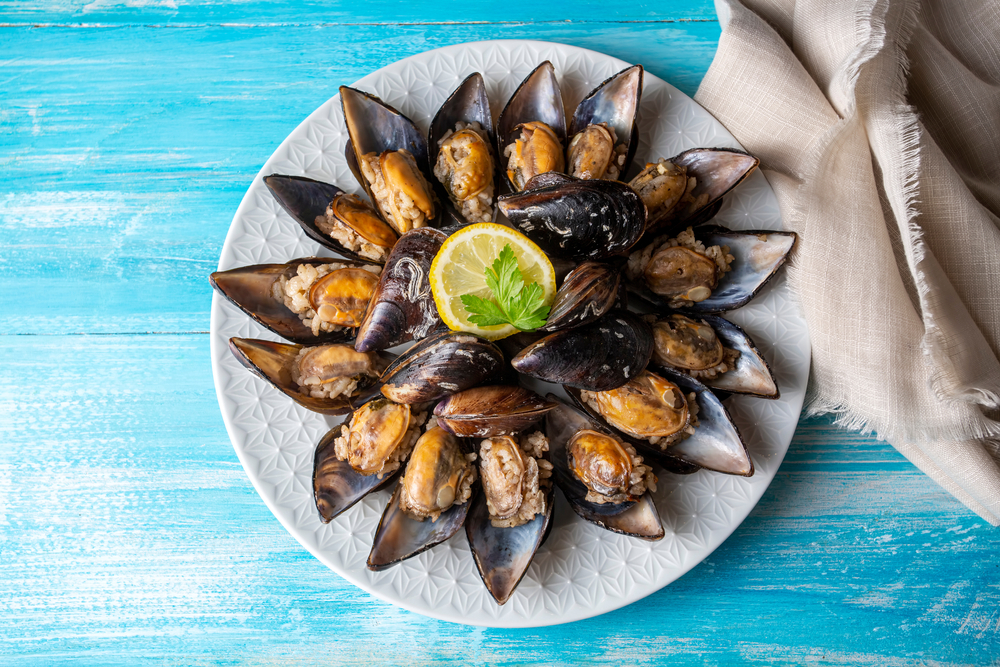
The place, which hosts antique shops and second-hand bookstores under the historically covered bazaar structure, has become a place frequented by antique lovers and collectors in Kemeraltı. The second-hand booksellers offer books that still carry the smell of the Period they were written, while the antique shops deal in artifacts and goods that once saw their prime in our country and became the object of many stories. After checking out the artifacts, you can have a snack in the cafe's nostalgic atmosphere of the café inside the bazaar, or you might want to take a break at the famous pide (pita) maker right past the bazaar.
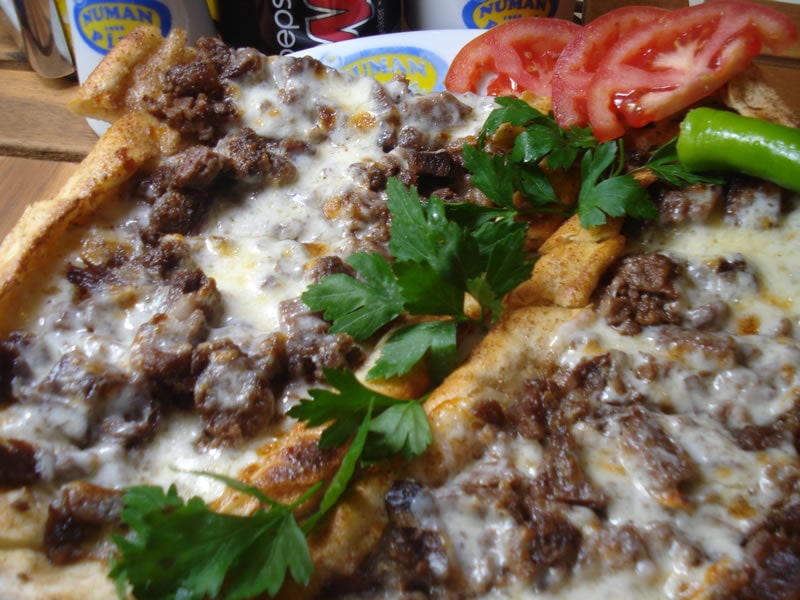
Another majestic mosque built along the arc of the old inner port in Kemeraltı is Başdurak Mosque. The mosque, which takes its name from its location in the Başdurak region, was built by the grain merchant Hacı Hüseyin Bey in the 17th century, according to the notes of Evliya Çelebi. The mosque's only lead-covered dome and its only minaret made of ornately carved stones are worth a closer look. The interior and exterior of the building are covered in patterns and hand-drawn ornaments in a display of the elegant visual arts of the Period. The restoration works carried out by the İzmir Chamber of Commerce in 2017 included the renovation of the stores under the Basdurak mosque and brought the "Başdurak Kemeraltı Touristic Handicraft Market" to life. In these shops, you can meet the artisans who work on traditional handicrafts such as felt making and leather making in person and have the chance to examine their works. If you wish, you can also visit the famous black mulberry sherbet and pickle shops around the mosque and taste these famous delicacies. Among the basic Ottoman sherbets, black mulberry sherbet, also known as black mulberry syrup, is believed to cure various diseases.
.jpeg)
Abacıoğlu Inn is one of the inns subsequently built in the area, encouraged by the increasing port trade in the 18th century. Abacızade Hacı Mustafa Ağa commissioned it in the early 18th century. The building was used for accommodation, trade, and storage purposes and was located within the Jewish quarters, adjacent to the cellar of the Greek church. Featuring nine rooms and seven lower cellars at the time of its construction, Abacioglu Inn earned the Respect for History – Local Conservation Competition organized by the İzmir Metropolitan Municipality and Philippe Rotthier European Prize for Architecture awards with its restoration work that was completed in 2007. You can enjoy the historical inn at one of the nice food & beverage spots in the colorful two-story spaces overlooking its spacious tree-lined courtyard. You can also meet Rafael Palombo, whose family has been trading in the inn from generation to generation since the 1920s, and listen to his story.
Although the construction date of Piyaleoğlu Inn is unknown, it is thought that it was built in the first half of the 18th century. It is known that the inn, which was taken over by the Evliyazadeler, one of the well-known families of İzmir, towards the end of the 19th century, provided shelter to the villagers who brought goods from the provinces. By the 1970s, the inn was home to leather makers, shoemakers, and glassmakers, and today it houses numerous craft workshops. The current state of the inn is after the fire is repaired. Here, you can breathe in its spacious courtyard, visit the workshops, meet the artisans, and examine their remarkable works.
The inn, which also has an exit connecting to Havra Street and currently operates under the name L'agora, is among the one-of-a-kind stops to have some rest and visualize history amidst its boutique hotel, restaurant, and various shops. Commissioned by the Karaosmanoğlu family, a family of cotton exporters who were engaged in trade to Europe in the early 18th century, the inn was originally made of wood. Home to many artisans, such as tinsmiths, whitesmiths, and coppersmiths throughout history, the inn was rebuilt in 2016.
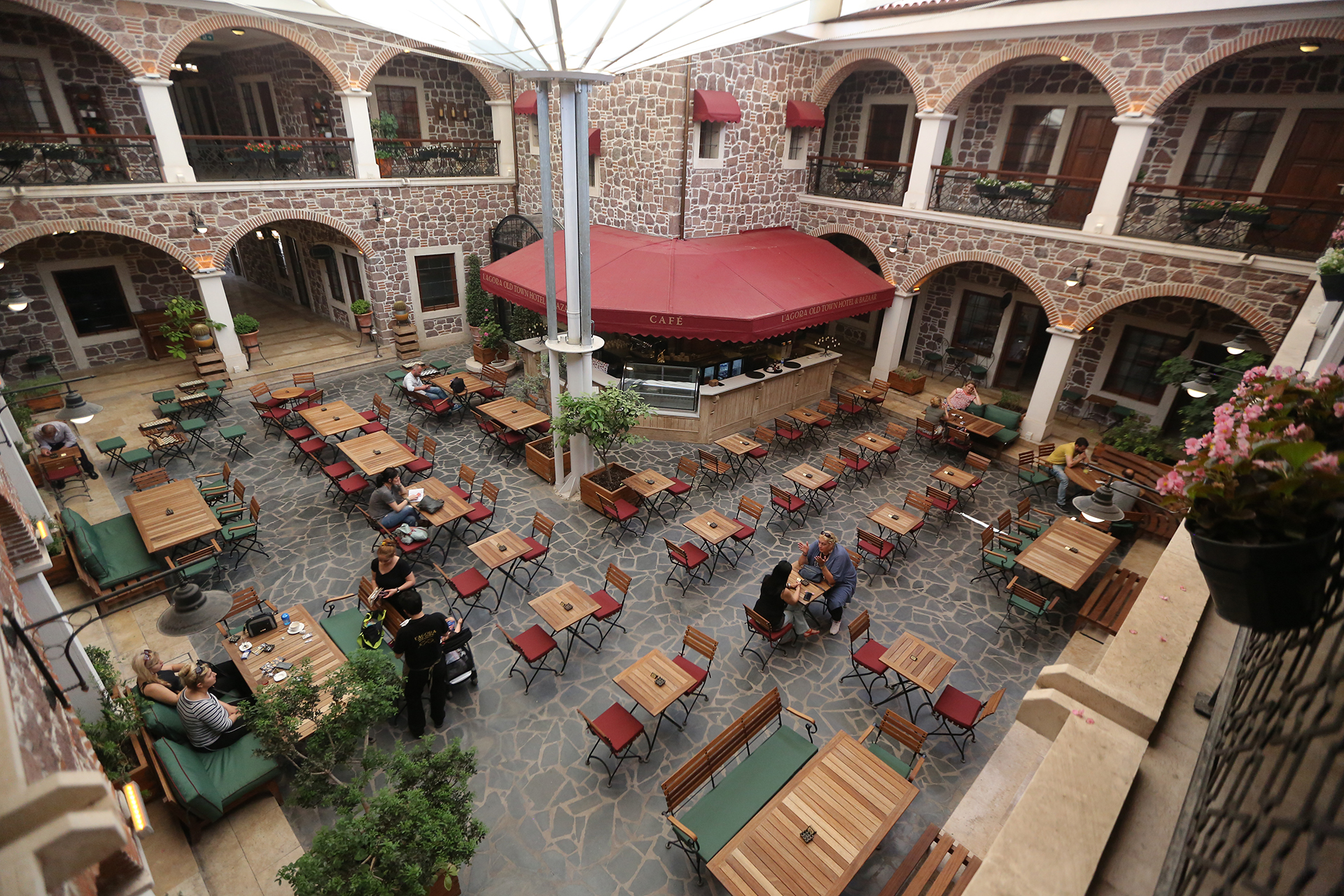
The Jewish community, whose presence in İzmir and its vicinity is thought to date back to the Roman Period, appears to have resided in small numbers in the city until the 16th century. With the foundation of the State of Israel, a large portion of the Jewish population of İzmir left the city. Especially since the last quarter of the 16th century, the Jewish population settled in and around Havra Street. It became an important part of the city by establishing Juderia, the Jewish quarter. Nine synagogues, four of which were built adjacent to each other, and the rabbinical building is surrounding the street form an architectural complex that is unique today. The sources from the 19th century reveal that Havra Street featured Greek and Jewish wineries, as well as a Turkish bath and a Greek pharmacy. On the street, traces of the historic winery can be seen from the grape and vine leaf motifs engraved on the keystone at the arched entrance. Although the street has lost its distinctive character, it retains its commercial texture and vivacious ambiance.
While on Havra Street, you may want to try the boyoz, which entered the culinary culture of İzmir with the arrival of Sephardic Jews. An unleavened pastry, Boyoz is derived from the Spanish word "bollos," which is the plural of "bollo," which means "small loaf." It has always been a deep-rooted tradition on the street where Kemeraltı artisans and regulars come to buy fruits, vegetables, fish, cheese, pickles, and halva. In the 1950s, thanks to the Jewish bakers who cooked only boyoz in the city, boyoz sales exploded all over İzmir, and pastry became indispensable for the people of İzmir. It gained the geographical name with name of "İzmir Boyuzu." Another flavor believed to have been introduced in the same way by Sephardic Jews is sübye, a fresh drink made from melon seeds that are often said to be consumed by the Jewish community on special occasions such as fasting and celebration.
.jpeg)
Mirkelamoğlu Inn was constructed in the last quarter of the 18th century. Mirkelamoğlu Inn is one of the few inns in the city that has preserved its original form to date and sets an example of classical Ottoman inner city inns with its two-storey and courtyard design. There is a beautiful fountain on the wall of the inn. As you enter the inn courtyard, you can listen to the 45's record store tunes, eat at the artisan restaurant, walk upstairs colored with flowers, and take a journey through history.
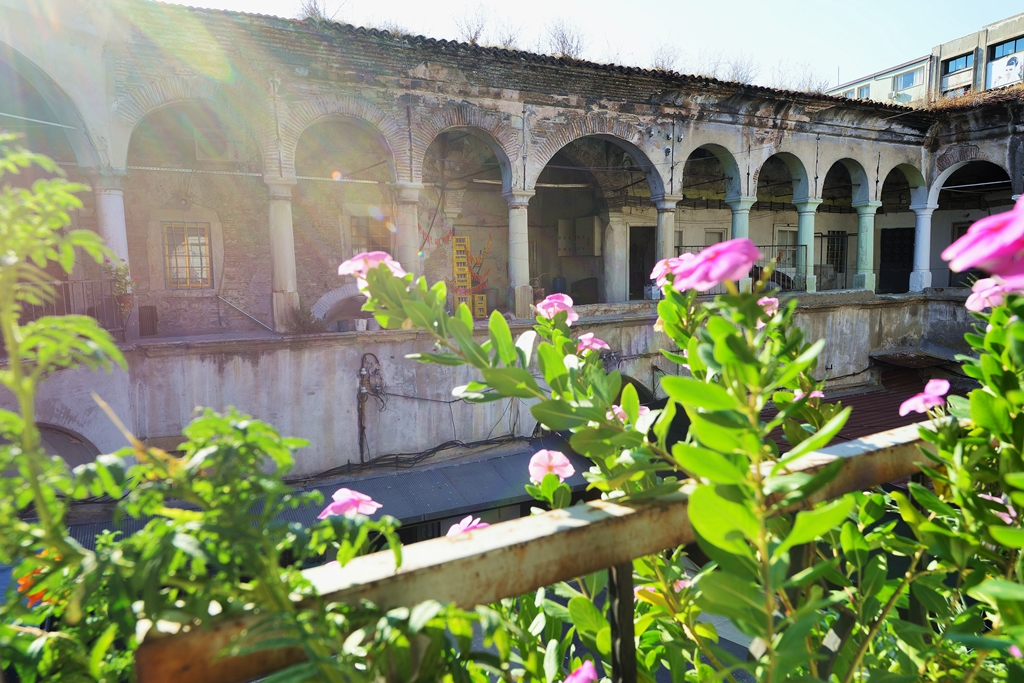
Kızlarağası Inn was commissioned by Hacı Beşir Ağa in 1744. Since the inn was built at the port's mouth and acted as a pier. The inn, which has a courtyard where caravans will leave their loads and several rooms on the upper floor that welcome weary travelers, maintained its importance in the commercial life of İzmir until the last quarter of the 19th century. Although the inn had played a significant role in the economy of İzmir, its importance began to decrease because the inner harbor was filled with the land. The historic inn was restored between 1988 and 92 and houses 200 small shops selling antiques, leather, jewelry, and souvenirs today. The inn's courtyard is one of the most popular coffee places in the historic bazaar. You can reach Hisaronu Square from the exit connecting to Hisar Mosque. Around this colorful and lively square, you can visit the artisan restaurants serving a wide variety of dishes, try fish, meatballs, and cold cuts vendors, as well as have a taste of the desserts associated with Kemeraltı such as ezme (paste), Şambali (a dessert made of semolina, sugar, and yogurt or milk) and Kazandibi (pudding with a caramel base). Şambali dessert, which also gained a geographical indication with its other widely-known name 'İzmir Şambali,' has become one of the unique flavors born in İzmir with the reinterpretation of the revani (baked semolina) dessert introduced to the city by the immigrants from the Balkans and the Aleppo dessert that was brought to the city through the migrations from Hejaz-Yemen.

Click here to see Secret Flavors of Kemeraltı Route on the map!
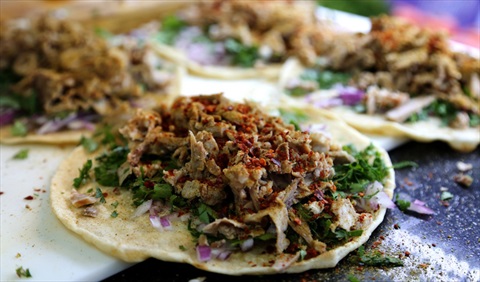
.jpeg)
.jpeg)
.jpeg)


Comments
No comment left, would you like to comment?